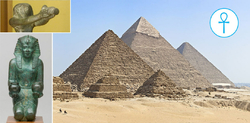- Retour accueil
- Vous êtes ici : Blog The Pyramids of the Cold The Pyramids of the Cold Section 16 • the Solvay process : the cooling of the Eye of Horus
The Pyramids of the Cold Section 16 • the Solvay process : the cooling of the Eye of Horus
Publié par Bruno Coursol dans The Pyramids of the Cold le 12/04/2022 à 20:03

On these images, the element that Horus is holding, is the fog nozzle of the horizontal evaporative cooling passage of the Great Pyramid of Giza. The nozzle produced a fog of microdroplets (the Dendera Light) that would naturally evaporate and cool the air inside the passage, most probably close to 5°C (41°F).
The Pyramids of the Cold - Section 16 • Solvay process : the cooling of the Eye of Horus
In summary : the Wedjat Eye of Horus (œil Oudjat) is an ancient Egyptian religious representation of the Falcon Headed god of the Sky Horus. It represents the disc of Sabu, inserted inside a Solvay counterflow reaction chamber where the overheat (the vulture) needed to be cooled down (by the snake), to complete the Solvay process cycles. The vulture overheating would have been fed by the evaporative cold snake. One of many feeding metaphors involving snakes and predator killing snakes.
The broken Eye of Horus is a metaphor of the failure in the mastering of this cooling process, that ended up with broken discs of Sabu into pieces.
16.01 Horus : the Falcon Headed ancient Egyptian god of the Sky
Wikipedia : "Horus is one of the most significant ancient Egyptian deities who served many functions, most notably god of kingship and the sky. He was worshipped from at least the late prehistoric Egypt until the Ptolemaic Kingdom and Roman Egypt. He was most often depicted as a falcon, or as a man with a falcon head".
"Additional meanings are thought to have been "the distant one" or "one who is above, over"
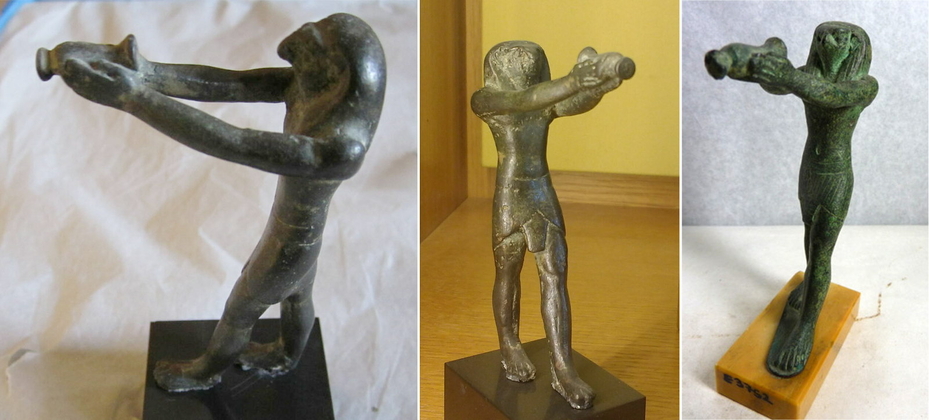
Horus figures from the Louvre Museum, Paris. DUT 162 (left and center) : https://collections.louvre.fr/ark:/53355/cl010409963 and E 3752 (right) : https://collections.louvre.fr/ark:/53355/cl010006611
16.02 Horus and the "libation vessel" pointed towards his head
In many occasions, the ancient Egyptian god of the sky Horus is represented holding what is commonly described as a vessel of some sort, often as some kind of libation vessel for honoring gods.
The problem with this assumption is the way Horus is holding the vessel. For example, in the Horus figure DUT162 from the Louvre, I find it very hard to see a libation vessel in Horus' hands.
I'm not controversial because I'm enjoying it, but can anyone tell me what the hell is Horus looking inside the libation vessel? Is he checking if there is maybe a spider, some change, a mouse or whatever?
Seriously, how can anyone believe it is a libation vessel that Horus is holding in his hands?

Antique brass fire fog nozzle : Vintage Brass Navy Water Fire Fog Nozzle (USS Kittson, 1944) from Chairish website.
16.03 The Horus' "libation vessel" is a fog nozzle
The fog nozzle of the Great Pyramid of Giza, seems to have been designed in a very similar way as a vintage brass fire nozzle, like the ones produced for the USS Kittson in 1944 (above left photograph).
Another difference of design between the Great Pyramid fog nozzle and the Kittson nozzle, is that the top part of the Kittson nozzle end, is actually designed for solid stream : there is an additional part that doesn't show on the bottom part of the nozzle.
If you take this top part and the handle out of the picture, the resemblance with the nozzle hold by Horus is stricking.
16.04 Horus' fog nozzle pointed towards his head : he is the beneficiary of the cold, and cooling himself
The fact that Horus has the fog nozzle pointed directly towards his head is crucial, because he is doing something that everybody has already done thousands of times : he is cooling himself, the same way we are doing when we are hot ourselves : we take a fan, pointed directly to our face, and we cool down.
Horus is the beneficiary of the cold.
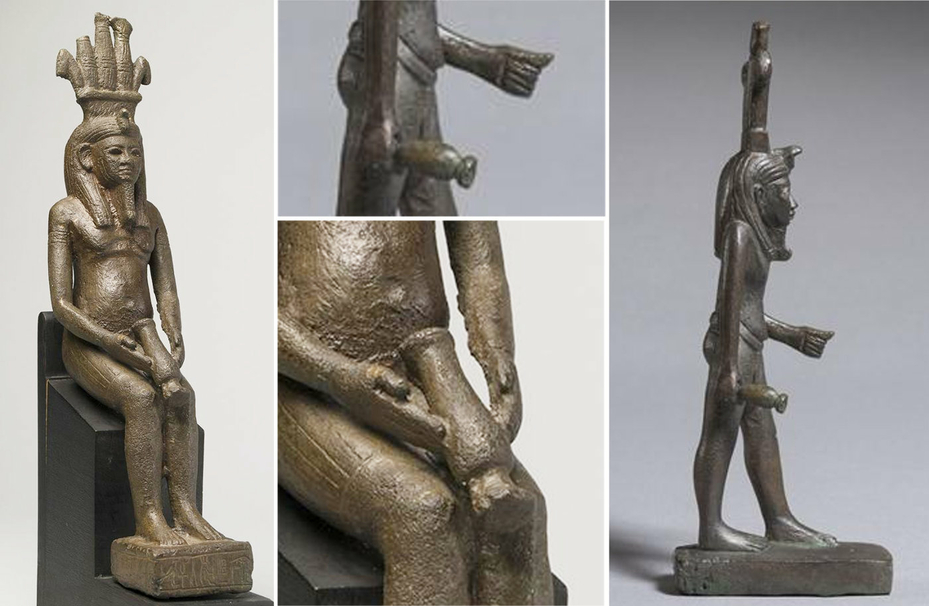
Hapi, the ancient Egyptian god of the annual flood of the Nile. Left : Statue of the God Hapy. Late Period, Dynasty 26, VII–VI cent. B. C. © The Pushkin State Museum of Fine Arts. Right : Statuette du dieu de la crue du Nil Hâpi, N5030 from the Louvre Museum (via l’Agence photo de la Réunion des Musées nationaux et du Grand Palais © Musée du Louvre, Dist. RMN-Grand Palais / Christian Décamps).
16.05 The "libation vessel" fog nozzle holded by Hapi, the god of the waters of the Nile
Horus is not the only god holding the fog nozzle, there is another god doing the exact same thing : Hapi, the god of the annual inundation of the Nile river. The way that Hapi is holding the fog nozzle should convince the greatest skeptics that this so particular element wasn't a libation vessel used for purification or baptism.
It is not a coincidence that Hapi is also holding the fog nozzle : Hapi was the god of the Nile, and we've already seen that the water used inside the Great Pyramid for the impactor to move and the cold to be produced, was also coming from the Nile.
16.06 Hapi's fog nozzle pointed towards his belly button : he is supplying the fog nozzle with water from the Nile
This time the fog nozzle isn't pointed to Hapi's face like it is the case on the Horus' figures, but it is pointed to its belly button, and that is a reference to the umbilical cord that is supplying the baby with oxygen and nutrients.
Contrary to Horus, Hapi is not a beneficiary of the cold, he is the one who created it in the first place : he was supplying the water and he was transfer it to the fog nozzle.
Another thing about deciphering the ancient Egyptian metaphors is that it is very difficult to get rid of our modern reflexes, of our modern way of thinking.
For example, when we've already seen in Section 7, that when Bes is holding a knife above his head, it has the exact same meaning of Maori traditional Haka performers, throat slitting themselves.
Here, the direction in which the fog nozzle is pointed to doesn't have any meaning : the metaphor is only about the fluid transfer, only about the umbilical cord. Hapi is simply represented supplying the fog nozzle with his water.
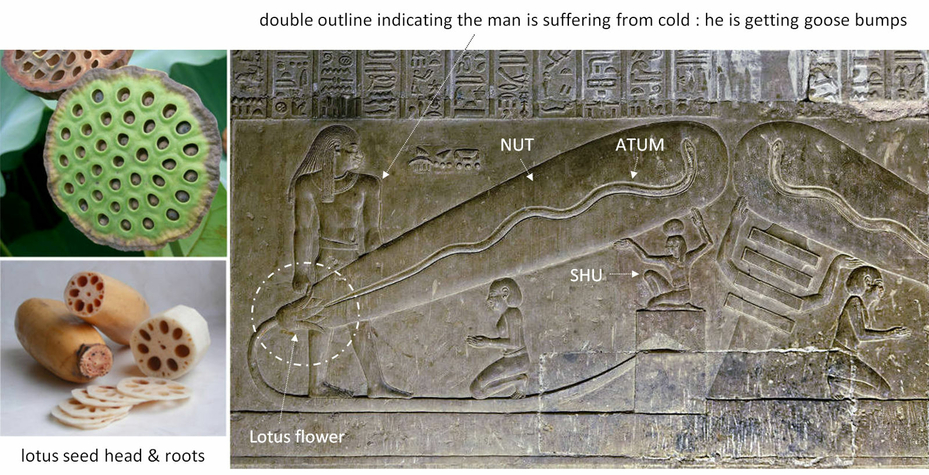
16.07 The Lotus Flower of Nefertem real meaning : the fog nozzle
We also know from the Dendera Light stone reliefs in the Hathor temple, that the Lotus flower was another representation of the fog nozzle : the Dendera Light bulb is originating from the Lotus Flower.
Most probably the metaphor about this Lotus Flower is about the very particular structure of its seed head that looks like a perfect shower head, and roots that are showing many tubes, a perfect metaphor of the water pipe.
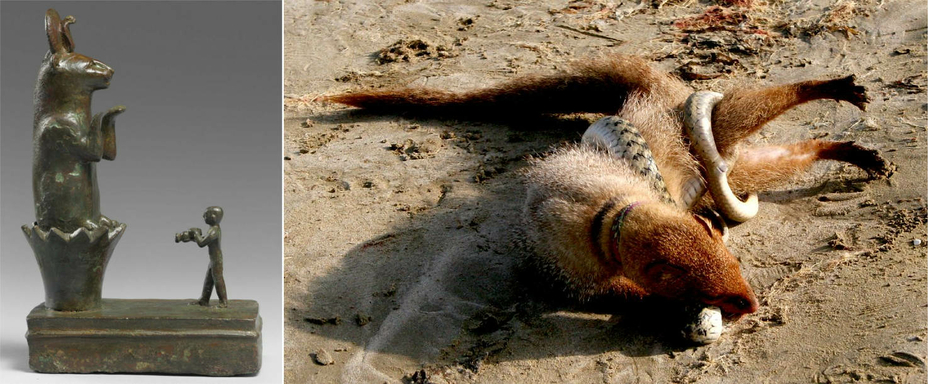
Exceptional photograph of a fight between a mongoose and a snake, thanks to Zahid Ali Khan, and posted on flickr : https://www.flickr.com/photos/zak24/130824707
16.08 The fights between Heat and its Cooling by animal metaphors
Because the Dendera Light bulb is originating from the Lotus Flower, we know that the Lotus flower was another representation of the fog nozzle : most probably the metaphor about this Lotus Flower is about the very particular structure of its seed head that looks like a perfect shower head, and its roots that are showing many tubes, a perfect metaphor of the water supply pipe of the nozzle.
The common thread between the Dendera Light relief (above) and the Mongoose artifact (below), is the Lotus Flower. The Lotus Flower being a representation of the fog nozzle, the Dendera Light bulb is a representation of the fog of microdroplets originating from the nozzle, but on the Mongoose artifact, the fog isn't depicted.
Instead there is a Mongoose, a ferocious animal for snakes.
The Mongoose is one out of many metaphors ancient Egyptians used to represent the heat produced by chemical manufacturing, and the endless fight between this heat and their efforts to cool down the process.

Egyptian Mongoose (ichneumon) E 14227 from the Louvre Museum, Paris © Musée du Louvre / Hervé Lewandowski.
16.09 The artefacts with a broken fog nozzle base
Please note that on this artefact E14227 from the Louvre, it seems that the base of the nozzle had been broken off : there is no clean cut. Most probably something was attached to it, and it should correspond to the end of the water supply pipe.
Same thing with the artefact N 5030 (above 16.05), as well as E 3752 (above 16.02), also from the Louvre.
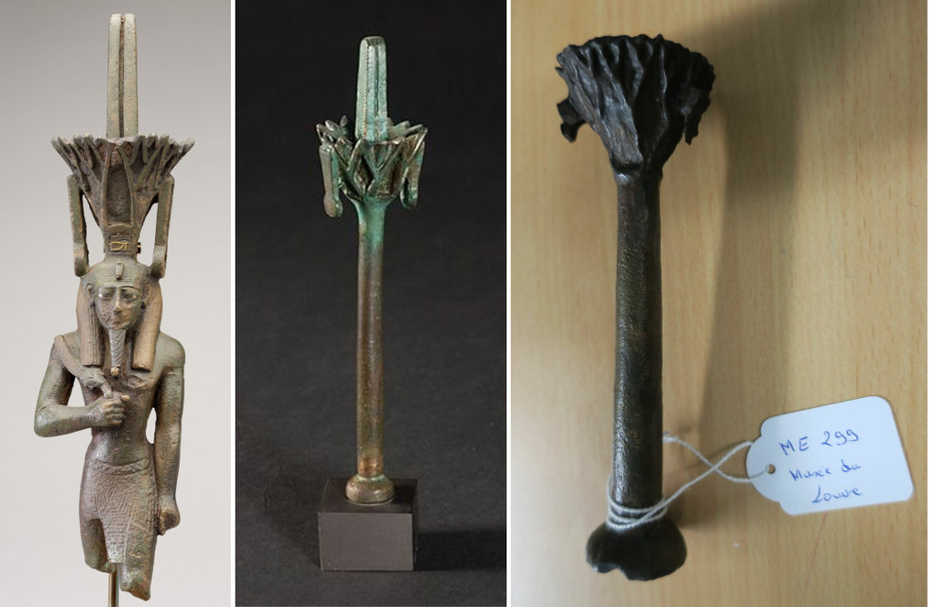
Nefertum figure from the Metropolitan Museum of Art : https://www.metmuseum.org/art/collection/search/551300
Nefertem emblem N 5118 © Musée du Louvre / Christian Décamps : https://collections.louvre.fr/ark:/53355/cl010008518
Nefertem emblem ME299 © Musée du Louvre : https://collections.louvre.fr/en/ark:/53355/cl010337234
16.10 The Nefertem emblem is the missing pipe of the fog nozzle
If a piece is really missing on some artifacts showing the fog nozzle, what should have been attached to it should have been the water supply pipe or a representation of it.
This water supply pipe that would have start from the exit of the inclined well, is actually perfectly documented because it is the emblem of the god of the Lotus Flower, Nefertem (also Nefertum).
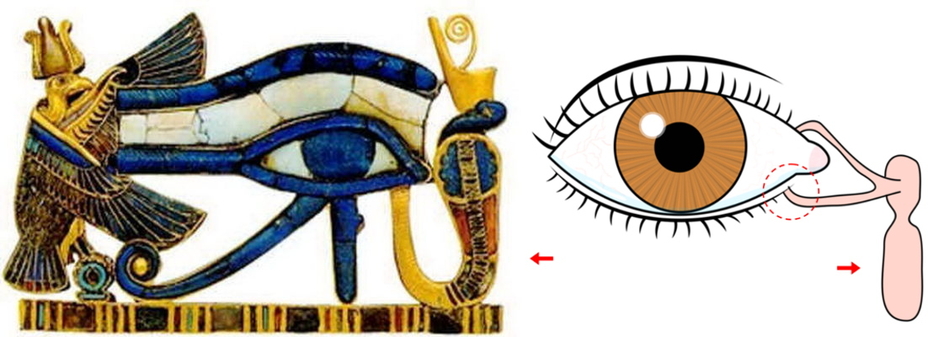
The Wedjat Eye of Horus is a representation of the cooling of the disc of Sabu. Lacrimal system thanks to Felipe Micaroni Lalli : https://commons.wikimedia.org/wiki/File:Sistema_lacrimal.gif
16.11 The Wedjat Eye of Horus and the water metaphor about the snake
To comprehend the real meaning of Horus, we need to understand what the Eye of Horus representations are really depicting.
The first thing to note is about the snake cobra, because its tail is connected to the Eye in a very particular location : the point where tears are coming from.
Once again, there is the water metaphor here, with the snake. It even looks like the snake is replicating the anatomic location and the physiological shape of the naso-lacrimal duct (red arrows). This shouldn't surprise anybody, because if absolutely no egyptologist would ever consider ancient Egyptians in a scientific and technological manner, everybody agrees that they were very advanced in the medical field. https://en.wikipedia.org/wiki/Ancient_Egyptian_medicine
The second point is the vulture with its wings deployed around the Eye : this is another metaphor of the fight between Heat and its cooling, because it is a fight between the vulture and the snake. Like the mongoose, vultures are other ferocious snake predators.
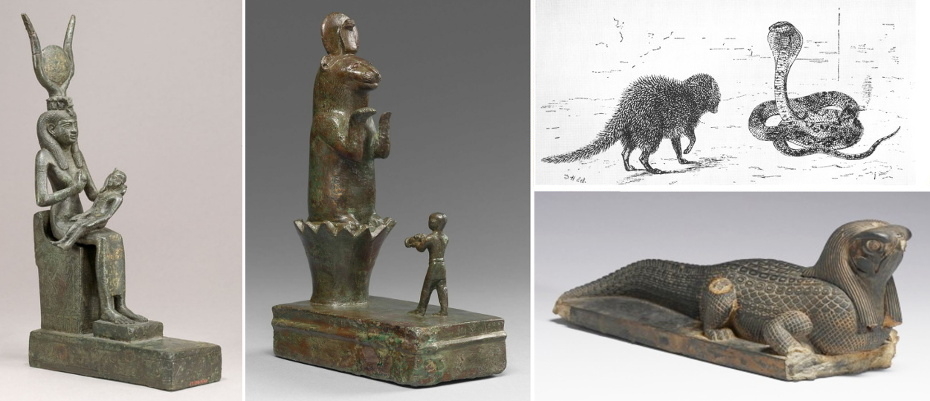
The ancient Egyptian god of the Sky Horus as a child, represented breast-fed by Isis and with a falcon head, holding the fog nozzle of the evaporative cooling passage of the Great Pyramid.
Left image : Isis nursing Horus from the Metropolitan Museum of Art, New-York. 1070–343 B.C. Third Intermediate Period–Late Period. Accession Number: 17.190.1641. Center image : Egyptian Mongoose (ichneumon) E 14227 from the Louvre Museum, Paris © Musée du Louvre / Hervé Lewandowski. Right image : Statue of a Crocodile with the Head of a Falcon AN 22.347 from the Walters Art Museum, Baltimore, Maryland.
Mongoose and Cobra drawing by General Douglas Hamilton : https://commons.wikimedia.org/wiki/File:MongooseCobra.jpg
The metaphorical representations of the Solvay chambers cooling
16.12 The metaphors about predators eating snakes
We've seen that the key element of the operating of the Great Pyramid, was the water and that it was represented by a snake. The great amount of pressurized water inside the inclined well was represented by the Great Serpent Apep (Apophis) and the small amount of water injected inside the evaporative cooling passage was represented in the Dendera reliefs by a small snake.
So the snake is a representation of the cold, and that cold was transferred to the Solvay towers. It is like the Solvay towers were needed to be fed with the cold. That explains why so many animals that are eating snakes as a regular diet, appear so often in ancient Egyptian religion scenes.
The mongoose, the hawk and vulture, the crocodile, the cat, the ibis... all of them are snake predators : they are nothing else than feeding metaphors for the Solvay reaction chambers.
Please note the hawk headed crocodile figurine on the above photograph. What these 2 animals have in common : they eat snakes.
16.13 The metaphors about the cooling fluid transfers
Horus is often represented on many figures as a child with Isis breastfeeding him. This scene is not to be taken literally.
Like everything else about ancient Egyptian religion, this is only a metaphor : there is no breastfeeding, and no Horus as a child.
The metaphor is about the transfer of the cooling fluid from the Queen's chamber to the Solvay towers. Isis is not giving milk to Horus, but the cold brine that was most probably circulating into the cold plate exchanger that was installed inside that chamber.
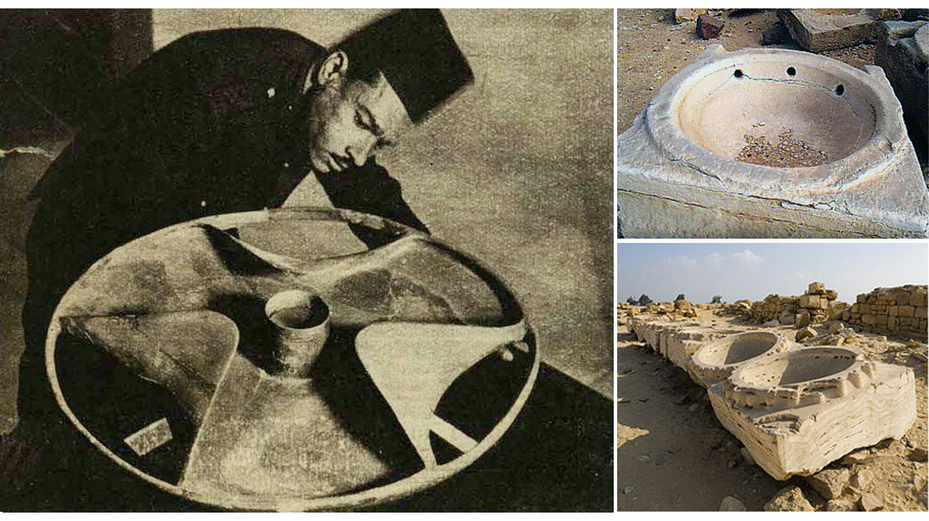
16.14 The Wedjat Eye of Horus is a representation of the cooling of the disc of Sabu
So we have the evaporative cooling representation (the snake = water = tear drops), as well as the Heat representation (the vulture eager to start eating the snake), and right in the middle is the Eye of Horus, a perfect shape in the form of a disc… a disc producing Heat that needs to be cooled down.
I think I'm not taking any risk by saying that the Wedjat Eye of Horus is a representation of the Disc of Sabu, the dome shaped and perforated plate that was set into overheating chemical reaction chambers for sodium carbonate (natron) and sodium bicarbonate manufacturing.
And in my opinion, we even know exactly what these reaction chambers would have looked like : the stone basins in the Sun temple of Nyuserre at Abu Ghurab.
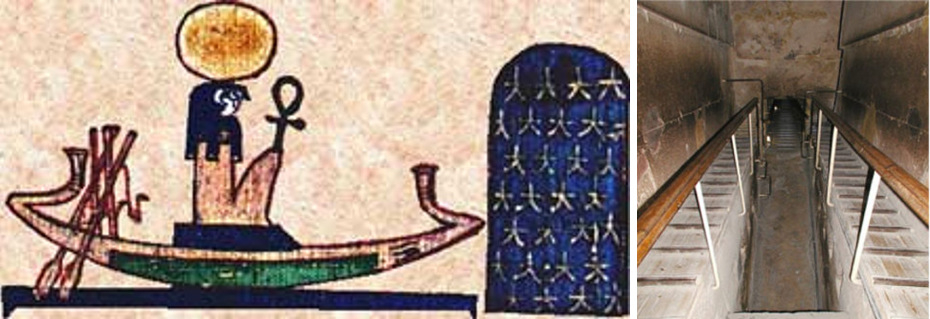
The solar barque entering the underworld primal waters is the representation of the impactor of the Great Pyramid entering the inclined well.
The 80 years of conflict and challenges between Horus and Set
16.15 Failure in the cooling process resulted in the breaking of discs of Sabu : it is the broken Eye of Horus
The disc of Sabu is made of metamorphic siltstone, a very fragile material that is actually a schist stone, and it had been entirely carved from a single block. When the balance between excessive heat and cooling failed, the discs of Sabu were susceptible to break over excessive thermal stress, whether it resulted from excessive heat or excessive cooling, in particular with direct water cooling.
"The Eye of Horus, wedjat eye or udjat eye is a concept and symbol in ancient Egyptian religion that represents well-being, healing, and protection. It derives from the mythical conflict between the god Horus with his rival Set, in which Set tore out or destroyed one or both of Horus's eyes and the eye was subsequently healed or returned to Horus." https://en.wikipedia.org/wiki/Horus
16.16 The wooden and stone boat race is a about the wooden cradle float and granite weight of the impactor
"… the other gods were getting tired from over eighty years of fighting and challenges. Horus and Set challenged each other to a boat race, where they each raced in a boat made of stone. Horus and Set agreed, and the race started. But Horus had an edge: his boat was made of wood painted to resemble stone, rather than true stone. Set's boat, being made of heavy stone, sank, but Horus' did not. Horus then won the race, and Set stepped down and officially gave Horus the throne of Egypt." https://en.wikipedia.org/wiki/Horus
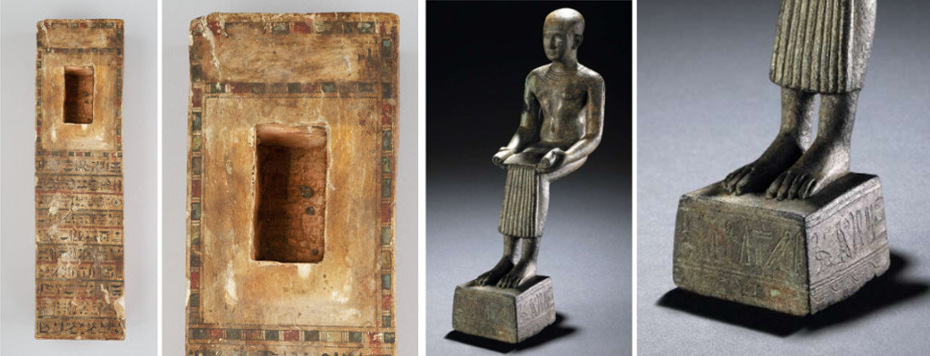
Images on the left : Ptah-Sokar-Osiris Figure, Accession Number: 21.9.1a-c from the Metropolitan Museum of Art, New-York. On view at The Met Fifth Avenue. On the right : Imhotep's figures showing the granite block weight, without the wooden cradle float : figure of Imhotep EA40666 from the British Museum
16.17 The race between Horus and Set on boats made of stone or wood is referring to the impactor
"… the other gods were getting tired from over eighty years of fighting and challenges. Horus and Set challenged each other to a boat race, where they each raced in a boat made of stone. Horus and Set agreed, and the race started. But Horus had an edge: his boat was made of wood painted to resemble stone, rather than true stone. Set's boat, being made of heavy stone, sank, but Horus' did not. Horus then won the race, and Set stepped down and officially gave Horus the throne of Egypt." https://en.wikipedia.org/wiki/Horus
The wooden cradle float that was the main structure of the impactor is represented in many Ptah-Sokar-Osiris figurine bases. The weight made in stone, most probably out of granite, is most of the time only fully represented on Imhotep's figures.
The wooden cradle and the granite weight combined together were forming the impactor, and this boat race involving boats made of wood or stone is all about the impactor.
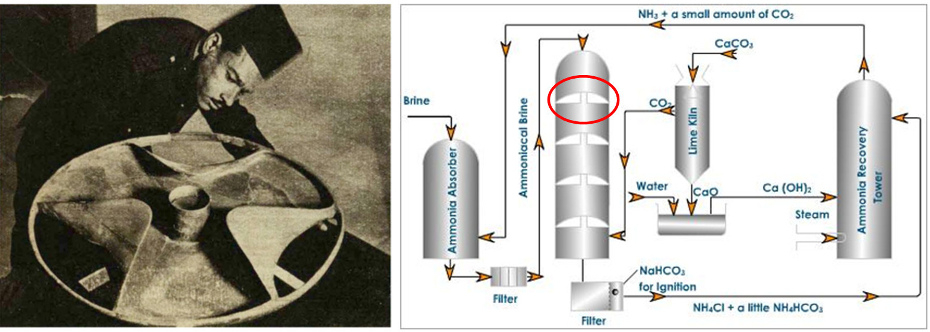
The disc of Sabu was installed inside chemical reaction chambers of Solvay towers, the Djed Pillars
16.18 Horus god of the Sky, but also the "distant one" or "one who is above, over"
Wikipedia : "Horus is one of the most significant ancient Egyptian deities who served many functions, most notably god of kingship and the sky. He was worshipped from at least the late prehistoric Egypt until the Ptolemaic Kingdom and Roman Egypt. He was most often depicted as a falcon, or as a man with a falcon head".
If we consider Horus to be the representation of the Natron manufacturing by the Solvay process and Set, as the overheating of the Solvay reaction chambers, it would explain a lot of things and in particular the famous conflict between Horus and Set, that lasted 80 years.
Horus can be tricky to understand, because he is a representation of the natron manufacturing that was located on the Upper Pyramid, but he was cooled down by the Lower Pyramid. That explains certain meanings of his name :
Wikipedia : "Additional meanings are thought to have been "the distant one" or "one who is above, over"
Horus, as the Natron manufacturing unit representation on the Upper part of the Great Pyramid was indeed away and over everybody who were working in the grand gallery, precisely to cool down the reaction chambers.
But some other clues also suggest that the elevation of the Great Pyramid wasn't finished at the time when it was functional and that there was kind of a flat roof, or partial flat roof, at the level of the Lady Arbuthnot chamber.
• The copper parts hammered down onto the doors (or Gantenbrink's slab) on the upper part of the Queen's northern and southern shafts.
• The change of direction of the northern King's chamber shaft
• The granite beams of the King's chamber complex that no longer rest on granite but on regular limestone blocks.
In other words, the Solvay towers would have been set in open air, on the Upper part of the Great Pyramid and that explains another name of Horus : god of the Sky.
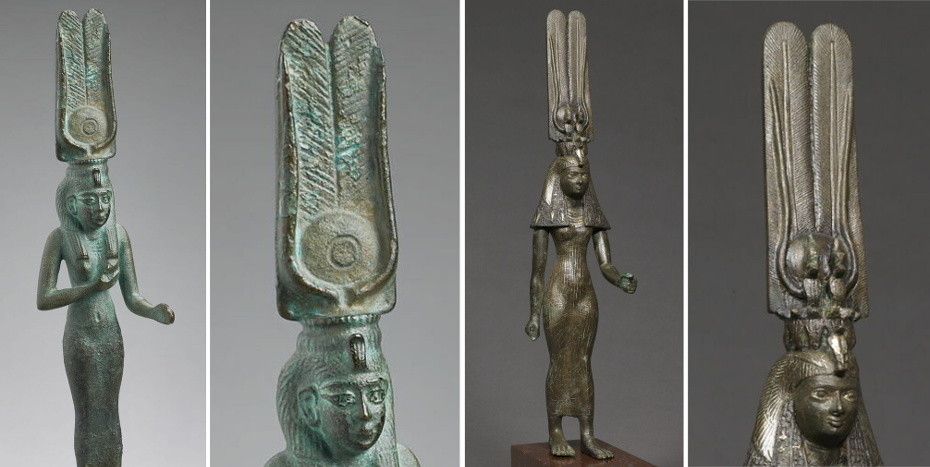
Goddess Isis breastfeeding Horus the Child N5091 from the Louvre Museum and N3808 also from the Louvre
16.19 Goddess Isis showing the plate cold exchanger and the cooling of the disc of Sabu
We've already seen that the goddess Isis, when breastfeeding Horus the Child, was actually a metaphor of the transfer of the cooling fluid that was coming from the Queen's chamber. Most of the time, nursing Isis figures don't show much information except for the cooling fluid pipe that looks like huge horns, and a very rough and simple shape of the disc of Sabu itself.
But on the figures from the Louvre Museum shown above, well apparently the artist who made the artifacts was given more leeway : the central hole of the disc of Sabu is clearly marked and the plate cold exchanger representation that was set in the Queen's chamber is also added.
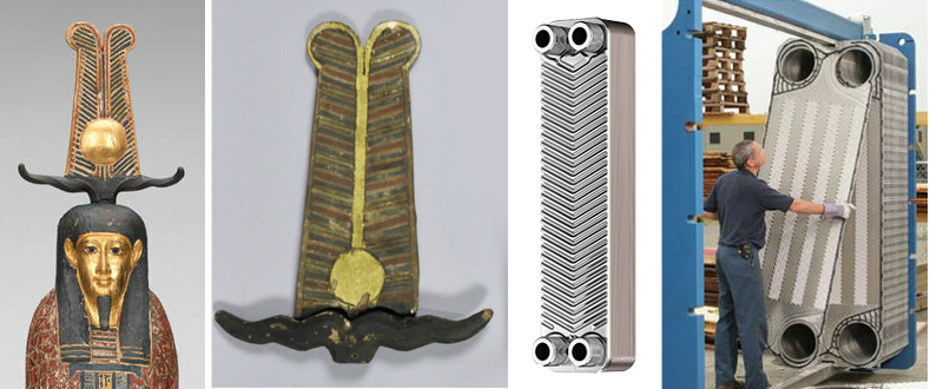
Left image from the Rhode Island School of Design (RISD), Providence : Ptah-Sokar-Osiris / wood, gesso, and paint, 332-30 BCE. Second image from the Penn Museum blog. Third image is a SWEP Plate Heat Exchanger and the last image is a complete plate heat exchanger from V Thermo Enterprises, Hyderabad, Telangana.
16.20 The cold plate exchanger in the Queen's chamber
What really was happening and what equipment was set inside the Queen's chamber is out of today purely hypothetical, but most probably a copper cold exchanger was in there to maximize the cold transfer.
Maybe the niche in the chamber was used for another equipment involved in the maintenance of the cold plate exchanger, but it is purely conjectural.
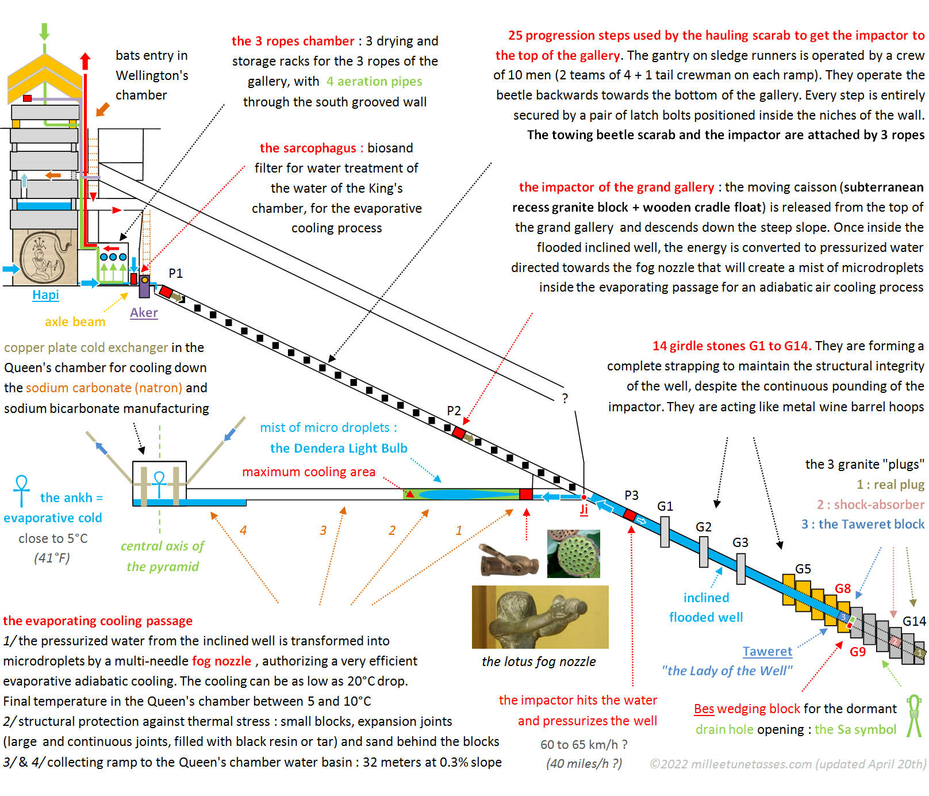
Diagram of the Great Pyramid of Giza in operation, before the shutdown procedure and the draining of the inclined well.
16.21 Summary of the study : hidden behind the academic vision of the ancient Egyptian religion, a vast number of metaphors are describing some of the most advanced science and technological knowledge of that time : ancient Egyptian gods were nothing else than pharaohs' metaphoric self-glorifications of their theoretical and experimental scientific accomplishments in physics and chemistry.
Pharaohs used the power of Science to legitimate themselves as kings of Egypt : they forged an entire religion, based on science to rule their kingdom, and they presented that science as Magic.
The end game of this technological program that probably started on the very first Dynasty, was the Great Pyramid of Giza where evaporative cooling was engineered in the known part of the pyramid from the pressurized water produced in the inclined well, known today as the ascending passage.
The evaporative cold simply took advantage of the power of water, and was most probably necessary to cool down chemical manufacturing of sodium carbonate and sodium bicarbonate produced by an ammonia-soda Solvay process, as suggested by the very strong ammonia smell and the limestone kiln in the so-called burial chamber of the Red Pyramid. At that time, sodium carbonate was called natron, and it was the salt used for the mummification of the pharaohs (Sections 14, 15 and 16).
The cooling seems to have represented the most difficult part of the process, as suggested by the Step Pyramid's official name : according to scholars, the very first pyramid complex, the Step Pyramid of Djoser, was called "the refreshment of the Gods". No doubt that a more accurate translation would certainly be "the cooling of the Gods".
It means that ancient Egyptians were the first civilization to master a Solvay-like process for sodium carbonate manufacturing, long before it got reinvented in the 1800's in Europe. The key elements of that process is the temperature control of the chemical reactions (the cooling), and the dome shaped plate necessary for the counterflow chemical reactions to occur in an efficient way. That counterflow reaction plate is what really is the disc of Sabu.
As shown with Akhenaten and Nefertiti, the creation of the evaporative cold was the most sacred accomplishment of all (Section 17), and this is exactly what the Dendera Light is all about : the Dendera Light is the fog of microdroplets of liquid water that evaporates and creates the cold. Talking about the snake inside the Dendera Light Bulb : "The field surrounding Ra’s snake form is referred to in ancient Egyptian literature as protective magical energy in liquid form that all gods and pharaohs possess" (Faulkner, Section 2).
Everything that had been done in the Great Pyramid of Giza inspired most of the ancient Egyptian religion, and it had been glorified into what we know today as the Underworld.
The Underworld is referring to the chambers and passages of the Great Pyramid of Khufu, and in particular to the Grand Gallery where a hauling gantry beetle operated a wooden coffin shaped impactor that had a small nested granite block inside it. The impactor generated endlessly, over and over, maybe every 15 minutes the pressurized water that was then transformed into a fog of microdroplets inside the horizontal cooling passage.
The Grand Gallery of the Great Pyramid where the act of hauling was done, is the "Secret Hauling Cavern of the Underworld" described in the Amduat "Book of the Hidden Chamber".
The most important chamber of the Great Pyramid wasn't the King's chamber that only was the main water tank of the pyramid, but the Queen's chamber, the only one on the central axis of the pyramid. Because the Queen's chamber was inaccessible from the rest of the pyramid, it was glorified into the "Hidden Chamber of the Underworld" (Section 11), and because the Queen's chamber was the coolest place in the pyramid (about 5°C / 41°F), and with a constant 100% Humidity rate, this chamber was the one where the biggest amount of very hard salt encrustation had been documented by the first explorers of the pyramid in the 1800's and before it had been removed in 1998 by Zahi Hawass (Section 1). Very hard salt encrustation is the signature of the evaporative cooling process, even nowadays.
The most incredible thing is that pretty much everything I've just said, actually appears in one single myth, but it doesn't originate from ancient Egypt : it is the "Churning of the Ocean" Hindu myth that produces the immortal nectar Amrita. The fact is that the endless churning of water that ends up with the production of an elixir that gives eternal life, is exactly what were doing ancient Egyptians in the inclined well : natron was the salt used for the mummification of pharaohs.
Natron gave eternal life to pharaohs, just like the Amrita (Section 19).
Poster un commentaire

